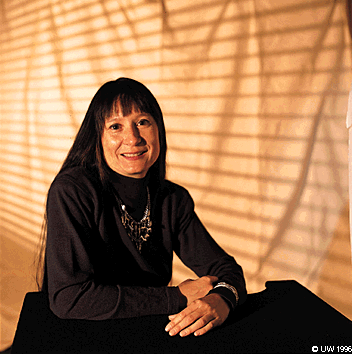

Now an associate professor of American ethnic studies at the University of Washington, Root is asking the questions and seeking answers in her latest book, The Multiracial Experience.

UW American Ethnic Studies Professor
Maria Root. Photo by Mary Levin.
The thrust of her work (this is her second book on the subject) is to recognize people of mixed racial heritage and point out the injustices they've faced their entire lives.
This hot-button topic is especially timely as the 2000 census approaches. Currently, biracial and multiracial people do not have a box to check on forms. Being forced to choose only one race "forces us to deny one of our parents," says Susan Graham, president of Project Race, a Roswell, Ga.-based non-profit organization leading the movement for a multiracial classification. "Multiracial people should have the option of recognizing all of their heritage. Multiracial is important so children have an identity; having to check 'other' on a form means they are different, and that is a label no person should have to bear."
To date, five states (Ohio, Illinois, Georgia, Indiana and Michigan) have passed legislation for multiracial classification. Two other states (North Carolina and Florida) are using the classification as well, and in 1995, the ACT college entrance test added a multiracial category.
The UW does not have a specific box for multiethnic (among its 15 race categories and four Hispanic categories) but students are free to check several boxes. "We prefer to know what ethnic categories if they are multiracial, since telling us only multiracial doesn't really tell us enough if we are trying to consider diversity in admissions," explains W.W. "Tim" Washburn, executive director of admissions and records at the UW.
The decision whether to include such a category on the 2000 census will be made by the federal Office of Management and Budget. The 1990 census, by the way, listed 24 race classifications.
"Multiracial individuals no longer can be ignored, nor be alone among Americans in being denied the right of self-identification," argues Root.
But there is an equally strong argument against such a multiracial listing from some minority groups.
"A multiracial listing would be just like apartheid," argues Gary Flowers, director of the Lawyers Committee for Civil Rights Under the Law, an African-American organization based in Washington, D.C. "If someone checks multiracial, then he is taking away numbers from his own community. That would weaken the African-American community and all it has fought for." The Hispanic group La Rasa also agrees. The NAACP has not come out against the multiracial listing, though some members individually have expressed opposition.
You Don't Fit Neatly Into a Box
Hope in Hawaii: A True Multiracial Culture
A Bill of Rights for Multiracial Americans
Send a letter to the editor at columns@u.washington.edu.